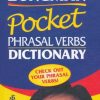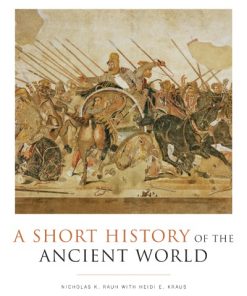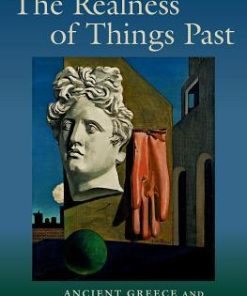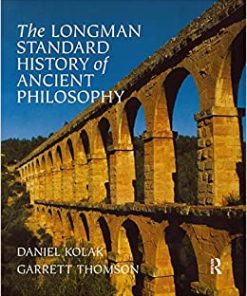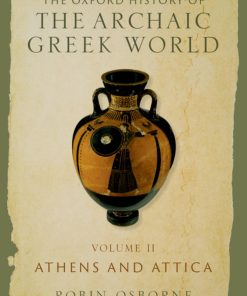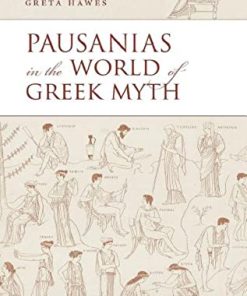Liddell and Scott The History Methodology and Languages of the World’s Leading Lexicon of Ancient Greek 1st edition by Christopher Stray, Joshua Katz, Michael Clarke 0192538829 9780192538826
$50.00 Original price was: $50.00.$25.00Current price is: $25.00.
Liddell and Scott: The History, Methodology, and Languages of the World’s Leading Lexicon of Ancient Greek 1st edition by Christopher Stray, Joshua T. Katz, Michael Clarke – Ebook PDF Instant Download/DeliveryISBN: 0192538829, 9780192538826
Full download Liddell and Scott: The History, Methodology, and Languages of the World’s Leading Lexicon of Ancient Greek 1st edition after payment.
Product details:
ISBN-10 : 0192538829
ISBN-13 : 9780192538826
Author : Christopher Stray, Joshua T. Katz, Michael Clarke
The Greek-English Lexicon of Liddell and Scott is one of the most famous dictionaries in the world, and for the past century-and-a-half has been a constant and indispensable presence in teaching, learning, and research on ancient Greek throughout the English-speaking world and beyond. Despite continuous modification and updating, it is still recognizably a Victorian creation; at the same time, however, it carries undiminished authority both for its account of the Greek language and for its system of organizing and presenting linguistic data. The present volume brings together essays by twenty-two scholars on all aspects of the history, constitution, and problematics of this extraordinary work, enabling the reader both to understand its complex history and to appreciate it as a monument to the challenges and pitfalls of classical scholarship. The contributors have combined a variety of approaches and methodologies – historical, philological, theoretical – in order to situate the book within the various disciplines to which it is relevant, from semantics, lexicography, and historical linguistics, to literary theory, Victorian studies, and the history of the book. Paying tribute to the Lexicon’s enormous effect on the evolving theory and practice of lexicography, it also includes a section looking forward to new developments in dictionary-making in the digital age, bringing comprehensively up to date the question of what the future holds for this fascinating and perplexing monument to the challenges of understanding an ancient language.
Liddell and Scott: The History, Methodology, and Languages of the World’s Leading Lexicon of Ancient Greek 1st Table of contents:
Part I. History and Constitution of the Lexicon
1. Liddell and Scott in Historical Context: Victorian Beginnings, Twentieth-Century Developments
1.1. Early Victorian Oxford: Institutional and Intellectual Contexts
1.2. The Vernacular Turn
1.3. The Lexicon and Other Dictionaries
1.4. The Development of the Lexicon Through its Eight Victorian Editions
1.5. The Lexicon as a Book
1.6. ‘Our two friends’
1.7. After Liddell: Twentieth-century Revision
1.8. Conclusion
2. Dictionaries as Translations: English in the Lexicon
3. Latin in the Lexicon
3.1. The Latin of Etymological Excursus
3.2. The Latin of Direct Transliteration
3.3. The Latin of Greek Descent
3.4. The Latin of Technical Terminology
3.5. The Latin of Ancient Idiom
3.6. The Latin of Scholarship
3.7. The Latin of Obscenity
3.8. quod superest: Latin without a Cause
3.9. Conclusion
4. Obscenity: A Problem for the Lexicographer
4.1. Introduction
4.2. The Nineteenth-century Context
4.3. Plain Speaking in the Vernacular: English Words in the Lexicon
4.4. Overt Markers of Obscene Content: ‘sens. obsc.’
4.5. Covert Markers of Obscenity: Latin in the Lexicon
4.6. Genitalia and Medical Terminology
4.7. Concluding Remarks
5. Etymology and Etymologies in the Lexicon
Part II. Periods and Genres of Evidence
6. Incorporating New Evidence: Mycenaean Greek in the Revised Supplement
6.1. On the Mycenaean Material in LSJ Revd Suppl.: Omissions and Inconsistencies
6.2. Whither Mycenaean in LSJ?
7. A Canonical Author: The Case of Hesiod
7.1. Introduction
7.2. LSJ and the Modern History of Hesiodic Vocabulary
7.3. Lexicography and Early Greek Epic
7.4. Lexicography and Hesiod
7.5. Concluding Thoughts
8. Philosophy and Linguistic Authority: The Problem of Plato’s Greek
8.1. Plato as Lexicographical Benchmark
8.2. Plato as Philosopher (a Breed Apart)
9. Medical Vocabulary, with Especial Reference to the Hippocratic Corpus
10. The Greek of the New Testament
10.1. Coverage
10.2. ΤΟ ΟΝΟΜΑ ΤΟ ϒΠΕΡ ΠΑΝ ΟΝΟΜΑ: New Testament Words and their Meanings
10.3. Personalities
10.4. Sources and Influences
10.5. Nineteenth-century New Testament Philology and LSJ’s Base Text
10.6. From ‘N.T.’ to NT’: the New Testament as a Corpus and Canon in LSJ
10.7. Conclusion
11. The Ancient, the Medieval, and the Modern in a Greek-English Lexicon, or How To Get Your Daily ‘Bread’ in Greek Any Day Through the Ages
12. Greek Dialects in the Lexicon
12.1. Abstract
12.2. Introduction: Looking up Dialect Words in LSJ
12.3. A Basic or Default Dialect?
12.4. The ‘Common Form’
12.5. A Similar Concept in Ancient Grammatical Texts
12.6. The First Edition of Liddell and Scott
12.7. Gewöhnliche Formen and Gemeine Formen in Passow 1830
13. Between Cunning and Chaos: μῆτις
13.1. Of Greek, German, and English: Liddell and Scott and their Predecessors
13.2. ΜΗτις from LS to LSJ: Between Scholarship and Idiosyncrasy
13.3. Changes Between the First and the Eighth Edition
13.4. Exploring the Changes in the Ninth Edition (LSJ)
13.5. Descendants and Rivals
13.6. Two Other Friends: Detienne and Vernant
13.7. Constructing a Definition of μητις
13.8. Conclusion
Part III. Methodology and Problems
14. Looking for Unity in a Dictionary Entry: A Perspective from Prototype Theory
14.1. Puzzling Polysemy in Early Greek
14.2. Unity and Disunity: the Case of μϵνος
14.3. Prototype Semantics
14.4. Diachronic or Synchronic—or Both
14.5. Defining a Prototype Concept: the Case of αλσος
14.6. Metaphor and Metonymy in Cognitive Semantics
14.7. Words and World-Picture
15. Discourse Particles in LSJ: A Fresh Look at γϵ
15.1. Introduction
15.2. The Challenges of Particle Meaning
15.3. γϵ in LSJ
15.4. Distribution
15.5. Alternatives: Questions and Focus
15.6. An Updated Look
15.7. Non-at Issue Meaning
15.8. Conclusion and Prospects
16. LSJ and the Diachronic Taxonomy of the Greek Vocabulary
17. Literary Lexicography: Aims and Principles
17.1. Elevation and Heightening
17.2. Norm and Deviation
17.3. The Lexical Evidence for Ancient Greek
17.4. Distinguishing Normal and Deviant Usage
17.5. Normal and Deviant Usage: Lexicographical Procedures
17.6. Activated Connotations
17.7. Iconyms
17.8. Lexicographical Procedures for Iconyms
17.9. Literary Lexicography: Practical Recommendations for LSJ
Part IV. Comparisons in Time and Space
18. Lessons Learned During my Time at the Lexikon des frühgriechischen Epos
18.1. βαρΥς
18.2. δοΥ λος
18.3. ΕΑϕθη
18.4. Επομαι and Επω
18.5. στϵΥται, στϵΥτο
18.6. στρογγΥλωμα
18.7. χϵρνΗτιΣ
18.8. Conclusion
19. Diminishing Returns and New Challenges
19.1. Specimen Entries in an Imagined Poetic Lexicon of Classical Greek
20. Βάπτω: An Illustration of the State of our Ancient Greek Dictionaries
20.1. LSJ
20.2. LSJ Revd Suppl.
20.3. DGE
20.4. Montanari GI and GE
20.5. John Chadwick, Lexicographica Graeca
20.6. Biblical Lexicography
20.7. Future Approaches
20.8. Testing the Results Against New Material
20.9. Conclusions
21. Liddell and Scott and the Oxford English Dictionary
People also search for Liddell and Scott: The History, Methodology, and Languages of the World’s Leading Lexicon of Ancient Greek 1st:
liddell and scott greek lexicon unabridged
liddell and scott online
how to cite liddell and scott
liddell and scott greek lexicon pdf
liddell and scott pdf
Tags: Liddell, Scott, The History, Methodology, Languages, Ancient Greek, Christopher Stray, Joshua Katz, Michael Clarke
You may also like…
Poetry - American Poetry
A Lexicon of Greek Personal Names: Volume V.C: Inland Asia Minor J -S Balzat
Politics & Philosophy - Anthropology
A Short History of the Ancient World 1st Edition Nicholas K. Rauh
Poetry - American Poetry
Politics & Philosophy
The Realness of Things Past: Ancient Greece and Ontological History 1st Edition
Uncategorized
History - Ancient History
Religion & Spirituality - Religious Studies
Business & Economics - Economics



